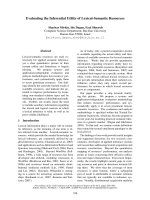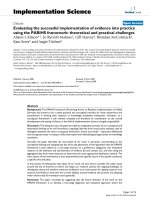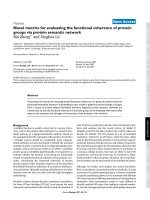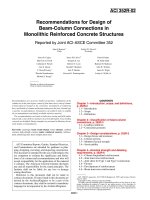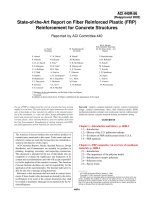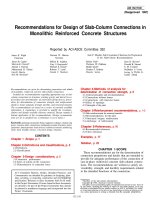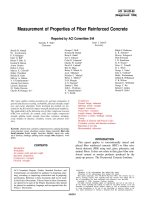Evaluating the long-term durability of fiber reinforced polymers via field assessments of reinforced concrete structures
Bạn đang xem bản rút gọn của tài liệu. Xem và tải ngay bản đầy đủ của tài liệu tại đây (8.34 MB, 179 trang )
THESIS
EVALUATING THE LONG-TERM DURABILITY OF FIBER REINFORCED
POLYMERS VIA FIELD ASSESSMENTS OF REINFORCED CONCRETE
STRUCTURES
Submitted by
Douglas Gregory Allen
Department of Civil and Environmental Engineering
In partial fulfillment of the requirements
For the degree of Master of Science
Colorado State University
Fort Collins, Colorado
Fall 2011
Master’s Committee:
Advisor: Rebecca Atadero
Paul R. Heyliger
Don Radford
UMI Number: 1503551
All rights reserved
INFORMATION TO ALL USERS
The quality of this reproduction is dependent on the quality of the copy submitted.
In the unlikely event that the author did not send a complete manuscript
and there are missing pages, these will be noted. Also, if material had to be removed,
a note will indicate the deletion.
UMI 1503551
Copyright 2011 by ProQuest LLC.
All rights reserved. This edition of the work is protected against
unauthorized copying under Title 17, United States Code.
ProQuest LLC.
789 East Eisenhower Parkway
P.O. Box 1346
Ann Arbor, MI 48106 - 1346
ABSTRACT
EVALUATING THE LONG-TERM DURABILITY OF FIBER REINFORCED
POLYMERS VIA FIELD ASSESSMENTS OF REINFORCED CONCRETE
STRUCTURES
Fiber Reinforced Polymer Composites (FRP) are an attractive repair option for
reinforced concrete structures, however their long term performance in field
environments is not well understood. Laboratory durability tests have indicated that FRP
generally performs quite well, but these laboratory tests cannot model the synergistic
effects that occur when the FRP is in-service on a bridge (or other structure). Field
assessments of FRP properties are very rare in the literature. This thesis describes an
effort to collect in-situ data about a FRP repaired concrete arch bridge.
The Castlewood Canyon Bridge on Colorado state highway 83 was reconstructed
in 2003. The reconstruction included replacement of the deck and spandrel columns and
repair of the existing concrete arches with externally bonded FRP. The FRP had been in
service for 8 years when its condition was assessed for this project.
Assessment efforts started with collection of as much information as possible
about the materials and techniques used for repair. Unfortunately only limited amounts of
initial or baseline data were recovered. Based on available information a tentative plan
for site assessment activities was prepared, including testing locations at the base and
crest of the arch.
ii
The field assessment of the bridge was completed on location during July, 2011.
The complete extrados of the east arch was inspected for voids between the concrete and
FRP using acoustic sounding and thermalgraphic imaging. Voids that were previously
identified during a routine bridge inspection in 2007 had grown significantly larger by the
2011 assessment. Pull-off tests were used to test the bond strength at the base and top of
the arch. Pull-off strengths were on average lower and represented different failure modes
from pull-off tests conducted at the time of repair. Large debonded regions of FRP were
cut from the structure to use in laboratory testing. Damaged regions were repaired with
new FRP.
Materials brought back from the bridge were used for tensile and Differential
Scanning Calorimetry (DSC) testing. The tensile tests showed that the FRP strength was
well below the specified design strength, but the lack of initial data makes it difficult to
tell if the material has deteriorated over time, or if the material started off with lower
strengths due to field manufacture techniques. The DSC tests showed that the glass
transition temperature of the composites was near the value suggested by the
manufacturer.
The field assessment was used as a case study in collecting durability data about
FRP. From this case study numerous recommendations are made to improve the available
information about the durability of FRP repairs in field environments. A specific process
to be followed in collecting this data is also proposed.
iii
ACKNOWLEDGEMENTS
I would like to thank my advisor, Dr. Atadero, for her guidance and assistance
with Oscar Mata physically completing the case study portion of this thesis at the
Castlewood Canyon Bridge. Also instrumental in the field assessment at the bridge were
CDOT’s personnel Thomas Moss and David Weld. Other CDOT personnel that helped
shape the project through meetings and feedback were Mike Mohseni, Aziz Khan, Trevor
Wang, Matt Greer, Eric Prieve, and William Outcalt. Steve Olsen and Stephen Henry
provided the instruction and use of the thermal camera, and Bill Schiebel and Roman
Jauregui coordinated to provide the box of files from the project. Nickolas Dickens
graciously provided a special use permit. Dr. Radford’s instruction and guidance in
regard to differential scanning calorimetry and glass transition temperature interpretation
were deeply appreciated. I would also like to thank Steve Nunn and Olley Scholer for
providing the FRP materials for the repair of the damaged areas caused during the case
study and their participation to smoothly accommodate our needs and inquiries of
material properties etc. Janice Barman and JR Santos provided their services in acquiring
materials and the manufacturing of the aluminum pucks used for the pull-off tests. I am
grateful for the participation of Dr. Heyliger, Dr. Radford, and Dr. Atadero as members
of my committee. Lastly, I feel forever indebted to my lovely wife, Emilie, for her
continued love and support through my toils.
iv
CONTENTS
1 Introduction
1
1.1 Overview
1
1.1.1 Failing Infrastructure and Bridges and Fiber Reinforced Polymers (FRP) as a Repair
Material
1
1.1.2 A Closer Look at FRP
4
1.2 Objective and Method
6
1.3 Organization of Thesis
7
2 Literature Review
2.1 Durability of FRP
2.1.1 Accelerated Ageing
2.2 Field Assessments
2.2.1 Macedonia, 2008
2.2.2 Northwest Region of U.S., 2005
2.2.3 New York, 2004
2.2.4 Utah, 2004
2.2.5 Summary of Field Evaluations of Durability
2.3 Nondestructive Evaluation Methods
2.3.1 Acoustic Sounding
2.3.2 Thermalgraphic Imaging
2.4 Tests
2.4.1 Pull-off Tests
2.4.2 Differential Scanning Calorimetry (DSC)
9
9
13
16
16
18
19
21
24
26
27
28
29
29
31
3 Case Study
3.1 The Castlewood Canyon Bridge
3.2 Renovation in 2003
3.2.1 Replacement of Spandrel Columns, Pier Caps, and Bridge Deck
3.2.2 Repair of Arches and Struts
3.2.3 Initial Values and Quality Control of the Renovation in 2003
3.2.3.1 Tensile Properties of CFRP
34
34
37
37
39
42
42
v
3.2.3.2 Bond Strength of CFRP
3.3 Biannual Bridge Inspections
3.4 Field Assessment of the Castlewood Canyon Bridge
3.4.1 Planning Tests and Locations
3.4.2 Preliminary Site Visit
3.4.3 Void Detection
3.4.4 Pull-off Tests
3.4.5 Collecting Specimens for Laboratory Testing
3.4.6 CFRP Repair
3.5 Laboratory Tests at Colorado State University
3.5.1 Tensile Tests
3.5.2 Differential Scanning Calorimetry (DSC)
3.6 Summary of Field Assessment and Laboratory Testing
44
47
51
51
54
59
61
75
80
84
84
94
104
4 Developing a Durability Model of FRP
4.1 Durability of FRP in Field Environments
4.1.1 What was learned in the Case Study?
4.1.2 Mock Example
106
107
108
114
5 Summary, Conclusion, and Additional Areas of Research
5.1 Summary
5.2 Conclusions
5.3 Additional Areas of Research
123
123
124
127
References
130
Appendices
Appendix A: Voids, Defects, and Thermal Images
Appendix B: Pull-off Tests
Appendix C: Tensile Tests
Appendix D: DSC
136
136
152
162
165
vi
LIST OF FIGURES
3.1 Castlewood Canyon Bridge location indicated by the red star
3.2 Castlewood Canyon Bridge (Mohseni, CDOT)
3.3 Castlewood Canyon Bridge prior to the 2003 repair (Mohseni, CDOT)
3.4 Castlewood Canyon Bridge after the 2003 repair (Mohseni, CDOT)
3.5 Plan view of the arches, struts, and column pedestals showing the bay labeling
Scheme
3.6 Systematically replacing the bridge deck (Mohseni, CDOT)
3.7 Placing the new spandrel columns adjacent to the existing columns (Mohseni,
CDOT)
3.8 Concrete spalling on arch section prior to repair (Mohseni, CDOT)
3.9 Concrete spalling on arch section prior to repair (Mohseni, CDOT)
3.10 Removal of loose concrete using 6.8 kg (15 lbs.) jackhammer (Mohseni, CDOT)
34
35
36
36
37
38
38
39
39
39
39
3.11 Restoring the cross section with shotcrete (Mohseni, CDOT)
3.12 Fyfe’s Tyfo® S Epoxy resin (likely with glass fibers as a filler) being applied to the
extrados of an arch (Mohseni, CDOT)
41
3.13 Installation of saturated unidirectional CFRP fabric, Tyfo® SCH-41
(Mohseni, CDOT)
41
3.14 Longitudinal and transverse CFRP wraps at the base of an arch
(Mohseni, CDOT)
41
3.15 Void injected with resin during 2003 renovation (Mohseni, CDOT)
45
3.16 Pull-off test locations from 2003 denoted in red
46
3.17 Outlined in permanent marker are identified areas of debonding between the FRP
and the substrate developed in the structure between inspections in 2007 and 2011.
Faintly denoted in the bottom of the photographs (enclosed in red circles) are
previously found voids identified with “DELAM 07” and lines distinguishing the
boundaries of the voids
49
3.18 Outlined in permanent marker are identified areas of debonding between the FRP
and the substrate developed in the structure between inspections in 2007 and 2011.
Faintly denoted in the bottom of the photographs (enclosed in red circles) are
previously found voids identified with “DELAM 07” and lines distinguishing the
boundaries of the voids
49
vii
3.19 Enclosed in permanent marker are identified areas of debonded areas between
the FRP and the substrate from 2011 and June, 2007. Notice in this more protected bay
of the structure the markings from 2007 are more clearly visible
50
3.20 Crack identified in 2007
50
3.21 Thermal image from an infrared camera of two voids, (appearing yellow), found in
2011 on the 1st bay on the north side of the east arch
59
3.22 Photograph of two voids, found in 2011 on the 1st bay on the north side of the east
arch
59
3.23 Two identified voids during the 2011 inspection, visible cracks in CFRP
60
3.24 Pull-off test locations highlighted in red
62
3.25 Damage caused by core bit without the use of the jig
63
3.26 Starting a core hole using a wooden jig
64
3.27 The core drilling location that failed due to torsional stresses during the core
drilling process, bay 1NW
65
3.28 The core drilling location that failed due to torsional stresses during the core
drilling process, bay 1NW
65
3.29 Removing water and debris from core cuts
65
3.30 Removing the acrylic paint later before adhering the aluminum pucks
66
3.31 Prepared areas for the adhesion of aluminum pucks for pull-off tests and a close-up
of a prepared surface
66
3.32 Prepared areas for the adhesion of aluminum pucks for pull-off tests and a close-up
of a prepared surface
66
3.33 Aluminum pucks before and after sanding with 40 grit sandpaper
67
3.34 Preparing the aluminum pucks way up high on the arch
67
3.35 Adhered aluminum pucks for pull-off tests
68
3.36 Spherical headed bolt threaded into puck
68
3.37 Placing the pull-off tester to engage the spherical headed bolt
68
3.38 Conducting a pull-off test with the digital manometer reading
69
3.39 Removing the tested puck from the pull-off tester
69
3.40 Failure Mode A: bonding adhesive failure at loading fixture
69
3.41 Failure Mode E: Adhesive failure at CFRP/substrate adhesive interface
69
3.42 Failure Modes B and F: cohesive failure in FRP laminate, and mixed cohesive failure
in substrate and adhesive failure at the adhesive/substrate interface, respectively
70
3.43 Failure Mode G: cohesive failure in concrete substrate
70
3.44 Failure Modes of Pull-off Tests from 2003 and 2011
71
3.45 Histogram of Pull-off Test Strength
74
3.46 PDF of Pull-off test results
74
3.47 Areas removed are highlighted in green
76
3.48 Void in CFRP with transverse crack identified with red arrows
77
3.49 Cutting the perimeter of the void in the CFRP
77
3.50 Water exiting the void area directly after the lower cut through the CFRP was
completed
78
viii
3.51 Cracks in the substrate were transmitted through the CFRP and notice the smooth
texture and blue and white color of the underside of the CFRP
78
3.52 Cracks in the substrate were transmitted through the CFRP and notice the smooth
texture and blue and white color of the underside of the CFRP
78
rd
3.53 Voids found in the 3 bay on the north end of the east arch
79
3.54 Removal of the CFRP of the largest void
79
3.55 Epoxy filled holes following the pull-off tests
80
3.56 Applying a primer coat to the areas for repair
81
3.57 Allocating fabric for repair
83
3.58 Applying the second layer of CFRP to the area of pull-off tests on the east arch
83
3.59 The repaired sections on the north end of the arches
83
3.60 The repaired sections on the north end of the arches
83
3.61 The rough contour of a tensile test strip of CFRP
85
3.62 Failed tensile test specimens from the large void removed from bay 3NE, note the
oatmeal appearance
86
3.63 Failed tensile test specimens from the small void removed from bay 1NE, note the
milky appearance
87
3.64 Distribution of Tensile Strength Results
87
3.65 Distribution of Modulus of Elasticity Results
88
3.66 Probability Density Function of the Two Samples, Tensile Strengths
90
3.67 Probability Density Function of All Tensile Tests
90
3.68 Probability Density Function of the two samples, Modulus of Elasticity
91
3.69 Probability Density Function of All Modulus of Elasticity Samples
91
3.70 Probability Density Function of the Rupture Strain of All Tensile Tests
93
3.71 Ground CFRP, Diced CFRP, and Diced Filler Resin
95
3.72 DSC Specimen Chamber
96
3.73 DSC with Liquid Nitrogen
96
3.74 Temperature vs. Time of the DSC Analysis for the Ground CFRP1 Specimen
97
3.75 Ground CFRP Specimen
98
3.76 Ground CFRP1A
99
3.77 Heat-Cool-Reheat-Cool of the Same Specimen
100
3.78 Ground CFRP2
100
3.79 Ground and Diced CFRP DSC Results
101
3.80 Filler Resin DSC Results
102
A1 Bay 1NW, 2 of the 3 small voids and rust spot
139
A2 Photograph and thermal image of rust spot
139
A3 Bay 1NE, 5 voids
140
A4 Bay 1NE, 4 of the 5 voids; Crack exists, enclosed in red oval, in the top of the largest
void
140
A5 Photograph and thermal image of two voids in Bay 1NE
141
A6 Bay 2NE, 3 Voids
141
A7 Bay 2NE, Crack enclosed in red oval was identified in 2007
142
ix
A8 Previously identified in 2007, a crack enclosed in the red oval, no debonding at the
location of the crack
142
A9 Bay 3NE with 1 of the 2 defects found in 2007 shown
143
A10 4 of the 5 voids found in 2011
143
A11 Enclosed in the red circle is 1 of the 2 voids found in 2007
144
A12 Photograph and thermal image of a seam in the CFRP sheets, no void present
144
A13 Bay 4NE, V-shaped silicone bead water diverter
145
A14 Bay 5NE
145
A15 Bay 5SE
146
A16 Bay 4SE
147
A17 Void from 2007 has grown and a new void developed
147
A18 Bay 3SE
148
A19 Thermal image of cracks previously identified in 2007
148
A20 Bay 2SE
149
A21 Photograph and thermal image of two voids
149
A22 Photograph and thermal image of two voids, the black color in the photograph is
left over strain gauges from the work done by Colorado University of Boulder
150
A23 Bay 1SE, 1 void
150
A24 Photograph and thermal image of a defect found in Bay 1SW
151
B1 Test No.1
B2 Test No. 2
B3 Test No.3
B4 Test No.5, note puck slid off of center while epoxy was setting
B5 Test No. 6
B6 Test No.7
B7 Test No.8, weak bond strength
B8 Test No.9, weak bond strength
B9 Test No.10, weak bond strength
B10 Test No.12, weak bond strength
B11 Test No.13, weak bond strength
B12 Test No.14, weak bond strength
B13 Test No.15, weak bond strength
B14 Test No.17
B15 Test No.18
B16 Test No.19
B17 Test No.20
B18 Test No.21
x
156
156
156
156
156
157
157
157
158
158
158
159
159
159
159
160
160
160
B19 Test No.22
B20 Test No.23, weak bond strength (poorly mixed concrete?)
B21 Test No.24
B22 Test No.25
B23 Test No.26 note very weak bond strength (poorly mixed concrete?)
B24 Test No.27
160
161
161
161
161
161
D1 Differential Scanning Calorimetry Curves
D2 Close up of Tg Regions
D3 Close up of Tg Regions
165
165
166
xi
LIST OF TABLES
3.1 ASTM D7522 Failure Modes
3.2 Failure Modes of the pull-off tests conducted in 2003
3.3 Summary of Failure Modes for the Pull-off Tests
3.4 Pull-off Test Results of Failure Mode G Tests
3.5 Material Properties of the Existing and Repair Materials
3.6 ASTM D3039 Letter Codes for Failure Modes
3.7 Material Properties of 2003 CFRP
3.8 Statistics from the Tensile Samples
3.9 Tyfo SCH-41 Rupture Strain Values
3.10 Rupture Strain Values from the 2011 Tensile Tests
3.11 Glass Transition Temperatures of CFRP and Filler Resins
46
47
70
72
82
86
88
89
92
93
103
4.1 Quantities of Samples and Specimens
4.2 Specific Amounts for Mock Example
121
121
A1 Summary of Voids on the Extradoses of the Entire East Arch and One Bay of the
West Arch
137
A2 Summary of Cracks on the Extradoses of the Entire East Arch
138
A3 Summary of Rust on the Extradoses of the Entire East Arch and One bay of the West
Arch
138
B1 Pull-off Test Results from 2011
B2 Pull-off Test Results from 2003
B3 Average Values of Bond Strength
152
153
155
C1 2011 Tensile Tests
C2 Average Values for each Sample
162
164
xii
CHAPTER 1: INTRODUCTION
1.1 Overview
1.1.1 Failing Infrastructure, Bridges and Fiber Reinforced Polymers
(FRP) as a Repair Material
In 2009, the American Society of Civil Engineers (ASCE) published an assessment
of the United States’ infrastructure in the form of a report card. The infrastructure was
differentiated into the following categories: Water and Environment, Transportation,
Public and Facilities, and Energy. The bridge section, within the Transportation category,
earned a grade of “C” requiring approximately “$17 Billion of annual investment to
substantially improve current bridge conditions” (ASCE 2009). It is estimated that “more
than 26%, or one in four, of the nation’s bridges are either structurally deficient or
functionally obsolete” (ASCE, 2009). A political awareness of the precarious state of US
bridges has sprouted due to the recent tragic structural failure of the I-35W bridge in
Minneapolis in 2007, in which 13 people died (Sofge, 2009). This reckoning has spurred
on funding of infrastructure with approximately $50 billion announced by President
Obama on Labor Day of 2010 (Huffpost, 2010). In order to maximize the return on this
investment, it is critical that an efficient approach is implemented in the maintenance,
repair, and replacement of our bridges.
1
A proactive and preventative management approach proves to be more cost
effective considering life cycle costs of structures such as bridges. In ”Too Big to Fall”,
Barry LePatner (2010) recognizes the need for well managed resources by emphasizing
W.R. De Sitters “law of fives”, which estimates that “when maintenance is neglected,
repairs when they become essential will generally equal five times maintenance costs; if
repairs are not made even then, rehabilitation costs will be five times repair costs.”
Coomarasamy and Goodman (1999) compare FRP with steel as repair materials
stating “the main advantages of FRP over steel for this application are that the FRP
materials do not corrode, have better electromagnetic properties, and have a higher
ratio of strength to mass density.” Tan et al. (2011) adds “Due to the lightweight and
high-strength, low costs, and convenience of construction, the strengthening method of
using bonded FRP has gradually taken the place of the traditional steel-encased method
and bonding steel method.”
Though FRP has potential as being an excellent solution to many of the
structurally deficient reinforced concrete bridges, this relatively recent innovation has
limited history (especially in field applications) and therefore its durability needs to be
verified. Chin et al. (1997) describes the need for and importance of conducting
durability studies on FRP materials:
“With the continuous deterioration of the world’s infrastructure, it has become
increasingly urgent to determine the feasibility of using high-performance
polymer composite materials in fabricating new structures as well as
rehabilitating existing ones.”
2
Moreover, “The durability of polymer composites is one of the primary issues
limiting the acceptance of these materials in infrastructural applications” (Chin et al.,
1997).
In an effort to satisfy the durability concerns, multiple durability studies have
been conducted in laboratories. The durability of FRP has been evaluated with
accelerated ageing through varying exposures to environments, solutions, and
temperatures. In some cases specimens have been aged on-site and/or with control
specimens. Inspiring a principle objective of this thesis, Karbhari et al. (2003)
determined “It is well established that durability data generated through laboratory
experiments can differ substantially from field data.” Similarly, Byars et al. (2003)
contributed “accelerated exposure data and real-time performance are unlikely to
follow a simple linear relationship and the relationships have yet to be confidently
determined”. Through field assessments additional information can be gathered, “data
that is invaluable to the establishment of appropriate durability based design factors”
(Karbhari et al. 2003).
A field assessment was conducted on the Castlewood Canyon Bridge as the case
study for this thesis to contribute to the long-term durability evaluation of fiber
reinforced polymer (FRP) materials used as externally bonded reinforcement for existing
reinforced concrete structures. Castlewood Canyon Bridge, built in 1946 and repaired in
2003, is a reinforced concrete arch bridge that spans Cherry Creek in Castlewood
Canyon State Park on Highway 83, south of Franktown, CO. Externally applied FRP
provided additional tensile reinforcement after the steel reinforcement had endured
3
corrosion. A comprehensive field assessment was conducted to evaluate the 2003 FRP
installation and identify the presence, location and severity of damage. By collecting
field data, the development of degradation can be further understood. As a result, the
process of collecting and documenting field data from conducting a field assessment
was established and refined.
1.1.2 A Closer Look at FRP
Fiber reinforced polymers are manufactured into bars or a fabric that is
saturated with resin in a “wet layup” process and are applied externally or “near surface
mount” (NSM) to provide tensile reinforcement to structures or structural members.
Repair and strengthening, terms used interchangeably throughout this paper, in shear
and/or flexure with wet layup of carbon fiber reinforced polymers (CFRP) on reinforced
concrete substrates are the main focus in this durability study.
Bakis et al. (2002) described FRP as a “combination of high-strength, highstiffness structural fibers with lightweight, environmentally resistant polymers” creating
“composite materials with mechanical properties and durability better than either of
the constituents alone.” The performance of FRP is dependent on the ability to transfer
stresses which relies on maintaining its material properties, bond strength, and the
strength of its substrate. Similar to the development length of rebar, Hu et al. (2004)
describes the importance of bond to the performance of the composite, “The usual
strengthening method is to bond the FRP laminates on the surface of concrete
structures, so the effect of strengthening is dependent on the bond behavior between
FRP laminates and concrete substrate.”
4
FRP has significant advantages to consider when compared with the
strengthening alternatives of using external steel plates or rebuilding large sections.
Strengthening reinforced concrete structures with FRP adds very little dead weight to
the structure and can be conducted relatively quickly, inexpensively, and with minimal
impact on traffic of lane closures or delays (Holloway, 2011). Hollaway (2011) adds
“Manufacturing technologies allow optimization and control of the structure of the
composite, e.g. fiber-matrix interactions, the fiber/volume ratio, degree of cure and
fiber arrangement.” These technologies provide the ability to “optimize the formation
process in terms of economics, productivity, product performance, quality, and
reproducibility” (Hollaway, 2011). Fiber reinforced polymers offer a much needed
solution to an overwhelming concern of safety that is our degrading infrastructure.
Environmental exposure and the quality of the on-site manufacturing process
(wet layup) can adversely affect the durability of FRP. Karbhari et al. (2003) identifies
the following environmental conditions of primary importance pertaining to the
durability of FRP composites: “moisture/solution, alkali, thermal (including temperature
cycling and freeze-thaw), creep and relaxation, fatigue, ultraviolet, and fire.” Saenz et al.
(2004) similarly identifies from Harries et al. (2003) findings “In 2002, ACI Subcommittee
440-D recognized that the most critical need for additional research is environmental
durability of FRP composite materials in concrete applications. ACI Subcommittee 440-L
established that the most critical and unique civil engineering environments to evaluate
are moisture, salt, and freezing and thawing, because these environments are typically
found in highway infrastructure.”
5
1.2 Objective and Method
The initial intention of this work was to conduct a field assessment to provide
some of the much needed data on the durability of FRP in field environments. In
initiating the process of conducting a field assessment many difficulties were
encountered which in turn further shaped and defined the goal and objectives of this
thesis. The more robust goal also includes establishing a procedure starting at the time
of FRP repair that will facilitate field assessments over the service life of the composite
to evaluate its durability. In order to reach this goal, the following objectives are
pursued:
Conduct a field assessment of an FRP repair and establish limitations or
weaknesses of current procedures followed at the time of repair and information
available for assessment.
Evaluate the durability of the FRP application to the extent possible with the field
assessment data
Propose enhanced procedures that would facilitate and improve the quality of
future assessments and lead to more usable durability data.
Provide an example demonstrating the feasibility of the proposed procedures.
To achieve the objectives previously explained, a case study was developed. An
FRP repaired reinforced concrete bridge, Castlewood Canyon Bridge on Highway 83 in
Colorado, was identified as a candidate for a field assessment. Inspection, evaluation,
and testing techniques that could identify the presence, location, and severity of
damage were chosen. The inspection, evaluation, and testing techniques were
6
conducted on the case study bridge. Values from the inspection, evaluation, and testing
techniques were compared to baseline values, previous values, and/or design
minimums to apply judgment as to how the structures response is affected.
The process described here as the method was then evaluated and areas of
potential improvement or optimization were identified. Improving the field assessment
process consists of causing less damage to the inspected structure while recovering
valuable data that can be more meaningful due to consistent and thorough
documentation.
1.3 Organization of Thesis
This thesis is comprised of five chapters. This chapter is Chapter 1: Introduction,
which begins with an overview of the condition of infrastructure and proceeds to
narrower in focus on bridges and FRP repairs. Following the overview, the objective of
the thesis is explained as well as the method in which the objective is attained.
Concluding the Introduction is this section on the organization of the thesis.
Chapter 2: Literature Review provides the background and additional
information on topics of significance to the remainder of the thesis. The topics that are
addressed include: durability of FRP, needs for data from field assessment and
previously conducted field assessments, and available evaluation and testing methods.
The actual process taken to satisfy the previously mentioned need of acquiring
data from field assessments is found in Chapter 3: Methods, Case Study. This chapter
describes the inspections and a test conducted on the Castlewood Canyon Bridge and
presents the results from the procedures. Chapter 3 also describes the procedure and
7
results of the tests conducted in the laboratories with specimens that were taken from
the bridge.
Chapter 4, Developing a Durability Model for FRP, was established from the
undertakings within Chapter 3. The difficulties posed by Chapter 3 became elements of
ways to improve the existing practices to accommodate a more streamline and robust
process of field assessments.
The final chapter, Chapter 5, is a summary and conclusion of the thesis and
describes additional areas of research.
8
Chapter 2: Literature Review
2.1 Durability of FRP for Repair
Tan et al. (2011) explains that “though the main factors affecting durability and
failure mechanism of concrete have been fully investigated, few studies on the
durability of FRP reinforced structures have been taken” and “factors affecting the
durability of FRP reinforced structures should be analyzed.” Tan et al. (2011) defines the
term “durability” as:
“the given structure under conditions of normal designing, constructing, serving
and maintaining can continue to perform its intended functions during the
specified or traditionally expected service life, in spite of structural performance
deteriorating with time.”
Similarly, the Civil Engineering Research Foundation (CERF) and the Market
Development Alliance (MDA) of the FRP Composites Industry in collaboration with
Karbhari et al. (2000) defined the term “durability” with respect to fiber reinforced
polymer composites as “the ability to resist cracking, oxidation, chemical degradation,
delamination, wear, and/or, the effects of foreign object damage for a specified period
of time, under the appropriate load conditions, under specified environmental
conditions” in their study of “Critical Gaps in Durability Data for FRP Composites in Civil
Infrastructure.” The term “durability” used throughout this thesis will be inclusive of
both definitions provided above by Tan et al. (2011) and Karbhari et al. (2000).
9
FRP materials have potentially high overall durability, however, Karbhari et al.
(2000) notes that “there is evidence of rapid degradation of specific types of FRP
composites when exposed to certain environments” and “actual data on durability is
sparse, not well documented, and in cases where available – not easily accessible to the
civil engineer.” Karbhari et al. (2000) continues that there is a “wealth of contradictory
data published in a variety of venues” resulting from the “reporting of data without
sufficient detail of the actual materials used, use of different forms of materials and
processing techniques, and even changes in the materials systems with time” (Karbhari
et al. 2000). Seven years later, Chen et al. (2007) agrees “although a number of
durability studies on FRP have been reported by various researchers, no general
conclusions are possible as researchers used different testing procedures and
conditions. In some cases, even conflicting results have been reported.”
The durability of an FRP composite is compromised if the material properties of
the FRP appreciably change or if the bond between layers of FRP or between the FRP
and its substrate becomes weak or is lost all together. Karbhari and Ghosh (2009)
identify the critical components of the performance of externally applied FRP, stating
“since the composite element is bonded onto the concrete substrate the efficacy of the
rehabilitation scheme depends on the combined action of the entire system with
emphasis on the integrity and durability of the bond between the FRP and concrete.”
Karbhari and Ghosh (2009) add “the performance characteristics of the substrate, FRP,
adhesive/resin forming the bond and the interfaces can all be deteriorated by
environmental exposure and hence there is a need to assess its effect on these
10
materials and on the bond itself.” Byars et al. (2003) agrees contributing “changes in
mechanical properties such as Young’s modulus, tensile and interlaminar shear
strengths and bond strength are the best indicators of changes in the performance of
FRP.”
Manufacturing, material components (fiber and resin types), environmental
conditions, and the quality of the application process all contribute to the durability of
an FRP composite. Prefabrication and wet layup are the two primary manufacturing
processes for strengthening applications of FRP. The wet layup process utilizes an
“ambient temperature cure resin system” (Karbhari and Ghosh, 2009) which has the
advantage of conforming to irregular shapes or areas of uneven geometry reducing
unbonded areas, but it may deteriorate faster than prefabricated bars or strips. As
described by Karbhari and Ghosh (2009) these prefabricated materials are based on
“well characterized high-temperature and controlled condition cure resin/adhesive
systems used for long–term durable bonds in the aerospace industry.” Durability of FRP
depends intrinsically on the choice of constituent materials, methods and conditions of
processing, and surrounding environmental conditions through their service lives
(Karbhari, 2003).
Karbhari et al. (2000) and Karbhari et al. (2003) identify identical environmental
conditions of primary importance pertaining to the durability of internal and external
applications of FRP: “moisture/solution, alkali, thermal (including temperature cycling
and freeze-thaw), creep and relaxation, fatigue, ultraviolet, and fire.” Coinciding with
Karbhari et al., Byars et al. (2003) considered similar environmental conditions that may
11
affect the durability of FRP: “moisture, chlorides, alkali, stress, temperature, UV actions,
carbonation and acid attack.” Numerous laboratory tests of the durability of FRP have
been conducted.
Previous laboratory studies have investigated the durability of both glass fiber
reinforced polymers (GFRP) and carbon fiber reinforced polymers (CFRP). From these
studies, it has been identified that different fiber types are susceptible or vulnerable to
different conditions. Karbhari and Ghosh (2009) found that “glass fiber reinforced
system undergoes slightly greater moisture initiated deterioration than the carbon fiber
reinforced system.” Fiber types can be optimized depending on the requirements of the
FRP application such as in Stallings (2000) study where GFRP was used for shear
strengthening and CFRP was used for flexural strengthening of bridge girders in
Alabama. The stronger, more expensive CFRP was used where durability was more
critical because the flexural strength was controlling, while the weaker, less expensive
GFRP plates were used to confine the flexural cracks and to add stiffness, reducing
deflections. Carbon fibers are less vulnerable than glass and will be the primary focus in
this thesis when discussing FRP.
The durability of fiber types alone is unfortunately not a comprehensive study of
the durability of FRP. Karbhari (2003) addresses this complexity stating “Although
carbon fibers are generally considered to be inert to most environmental influences
likely to be faced in civil infrastructure applications the inertness does not apply to the
fibre-matrix bond and the matrix itself, both of which can in fact be significantly
deteriorated by environmental exposure.”
12
